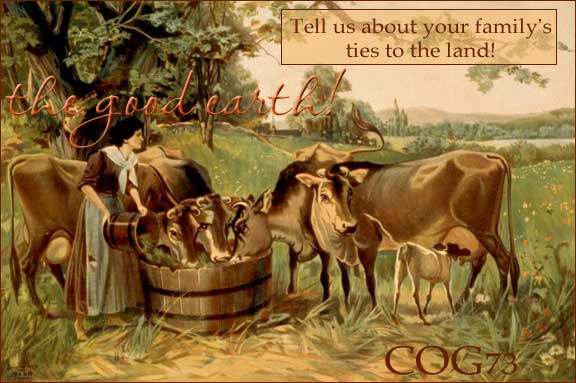Back on August 9, 2009, Randy Seaver presented another Saturday Night Genealogical Fun (SNGF) challenge for readers to document their sixteen great-great-grandparents. I responded to the call with Sweet Sixteen: My Great-Great Grandparents. But, my tree was a little bare in some spots. I did not know at least 4 names and was “iffy” on two more. In fact, I only had documented birth and death dates for 3 of the 16.
A few months later, I was able to update my list with A Sweeter “Sweet Sixteen” – I had documented proof of 4 of the missing names. Then, last year I attended the NGS conference in Salt Lake City and found a lot of additional information that was previously missing with many marriage and birth records.
Today, Randy posed a very similar SNGF challenge. I decided to take a look at my list to see what I had learned in the two years since my original post. While I still have a lot of research to do, I was able to add 4 of the “unknown” birth details into the “documented” category (which means I know the names of 8 more great-great-greats!). A bigger challenge was correcting the place names. Rather than simply put the name of the town and the current country, I attempted to figure out the town, county or equivalent, state or equivalent, and country name at the time of the event. For my Polish ancestors, whose borders changed more frequently than I can keep track of, Steve Danko’s post on Describing Place Names in Poland was invaluable. I hope I got them right!
Here is my revised/updated Sweet Sixteen:
Note: [d] = documented , [p]=presumed based on other documents
16. Stanisław Piątkowski
- b. 1842, Mogilev, Mogilev Gubernia, Russian Empire [p]
- m. Apolonia Konopka on 10 May 1863, Holy Cross Parish church in Warsaw, Warsaw Obwód, Mazowsze Voivodeship, Congress Kingdom of Poland [d]
- d. unknown [presumed Warsaw before 1900]
- Son of Ludwik Piątkowski and Benigna Kosecka
17. Apolonia Konopka
- b. 1842, Konopki, Augustów Gubernia, Poland [p]
- d. unknown [presumed Warsaw before 1900]
- Daughter of Stanisław Konopka and Rozalia Karwowska
18. Jan Kiziewieter
- b. 1831, unknown [Poland]
- m. Marianna Ostał before 1866 [p]
- d. unknown [between 1876-1900, presumed near Warsaw]
- Parents’ names unknown
19. Marianna Ostał
- b. 1833, unknown [Poland]
- d. unknown [after 1900, presumed Warsaw]
- Parents’ names unknown
20. Josef Bergmeister
- b. 09 Feb 1843, Puch, Pörnbach, Pfaffenhofen an der Ilm, Oberbayern, Bayern [d]
- m. Ursula Dallmeier on 11 Apr 1871 in Pfaffenhofen a.d. Ilm, Pfaffenhofen an der Ilm, Oberbayern, Bayern, Germany [d]
- d. unknown [presumed Regensburg or München before 1885]
- Son of Jakob Bergmeister and Anna Maria Daniel
21. Ursula Dallmeier
- b. 17 Mar 1847, Aichach, Aichach-Friedberg, Schwaben, Bayern [d]
- d. unknown [presumed Regensberg between 1897 – 1919]
- m2. Herman Götz by 1885 [p]
- Daughter of Josef Dallmeier and Ursula Eulinger
22. Karl Echerer
- b. 31 May 1846, Pfaffenhofen a.d. Ilm, Pfaffenhofen an der Ilm, Oberbayern, Bayern [d]
- m. Margarethe Fischer 18 May 1874, Pfaffenhofen a.d. Ilm, Pfaffenhofen an der Ilm, Oberbayern, Bayern, Germany [d]
- d. unknown [presumed after 1882, Pfaffenhofen a.d. Ilm]
- Son of Ignaz Echerer and Magdalena Nigg
23. Margarethe Fischer
- b. 21 Jan 1845, Langenbruck, Reichertshofen, Pfaffenhofen an der Ilm, Oberbayern, Bayern [d]
- d. 04 Oct 1895, Pfaffenhofen a.d. Ilm, Pfaffenhofen an der Ilm, Oberbayern, Bayern, Germany [d]
- Daughter of Franz Xaver Fischer and Barbara Gürtner
24. Józef Pater
- b. 21 Sep 1864, Ruda Guzowska, Błoński Powiat, Warsaw Gubernia, Kingdom of Poland [d]
- m. Antoninan Rozalia Pluta on 25 Aug 1885 in Mszczonów, Błoński Powiat, Warsaw Gubernia, Vistula Land, Russian Empire [d]
- d. 11 Aug 1945, Philadelphia, Philadelphia, Pennsylvania, USA [d]
- Son of Jan Pater and Teofilia Zakrzewska
25. Antonina Rozalia Pluta
- b. 11 Jun 1863, Mszczonów, Błoński Powiat, Warsaw Gubernia, Kingdom of Poland [d]
- d. 12 Dec 1938, Philadelphia, Philadelphia, Pennsylvania, USA [d]
- Daughter of Ludwik Pluta and Franciszka Wojciechowska
26. Jan Müller
- b. unknown [presumed Bohemia]
- m. Elżbieta Smetana by 1881 in unknown place
- d. unknown [presumed Żyrardów, Poland after 1909]
- Parents’ names unknown
27. Elizabeth Smetanna
- b. unknown [presumed Bohemia]
- d. unknown [presumed Żyrardów, Poland]
- Parents’ names unknown
28. Wawrzyniec Zawodny
- b. 11 July 1850, Wilczyn, Słupecki Powiat, Kalisz Gubernia, Kingdom of Poland [d]
- m. Katarzyna Mariańska on 10 May 1875 in Dobrosołowo, Słupecki Powiat, Kalisz Gubernia, Vistula Land, Russian Empire [d]
- d. 13 Dec 1917, Dobrosołowo, Słupecki Powiat, Kalisz Gubernia, Regency Kingdom of Poland [d]
- Son of Szymon Zawodny and Katarzyna Ratajewska
29. Katarzyna Mariańska
- b. 19 Oct 1852, Komorowo, Słupecki Powiat, Kalisz Gubernia, Kingdom of Poland [d]
- d. 29 Jul 1923, Dobrosołowo, Słupecki Powiat, Kalisz Gubernia, Republic of Poland [d]
- Daughter of Stanisław Mariański and Michalina Radomska
30. Wincenty Ślesiński
- b. 11 Jul 1850, Wilczyn, Słupecki Powiat, Kalisz Gubernia, Kingdom of Poland [d]
- m. Stanisława Drogowska 03 Sep 1879 in Wilczyn, Słupecki Powiat, Kalisz Gubernia, Vistula Land, Russian Empire [d]
- d. 01 Jan 1919, Dobrosołowo, Słupecki Powiat, Kalisz Gubernia, Republic of Poland [d]
- Son of Jozef Ślesiński and Elżbieta Michalowska
31. Stanisława Drogowska
- b. 04 Jun 1860, Wilczyn, Słupecki Powiat, Kalisz Gubernia, Kingdom of Poland [d]
- d. 30 Dec 1918, Dobrosołowo, Słupecki Powiat, Kalisz Gubernia, Republic of Poland [d]
- Daughter of Jan Drogowski and Konstancja Kubica
My ancestry remains the same as calculated two years ago: 62.5% Polish (the guy born in what is now Belarus is ethnically Polish), 25% German (technically Bavarian since Germany did not exist as a unified state until 1871), and 12.5% presumed Czech (Bohemian). Thanks, Randy, now those blanks are really bothering me!








